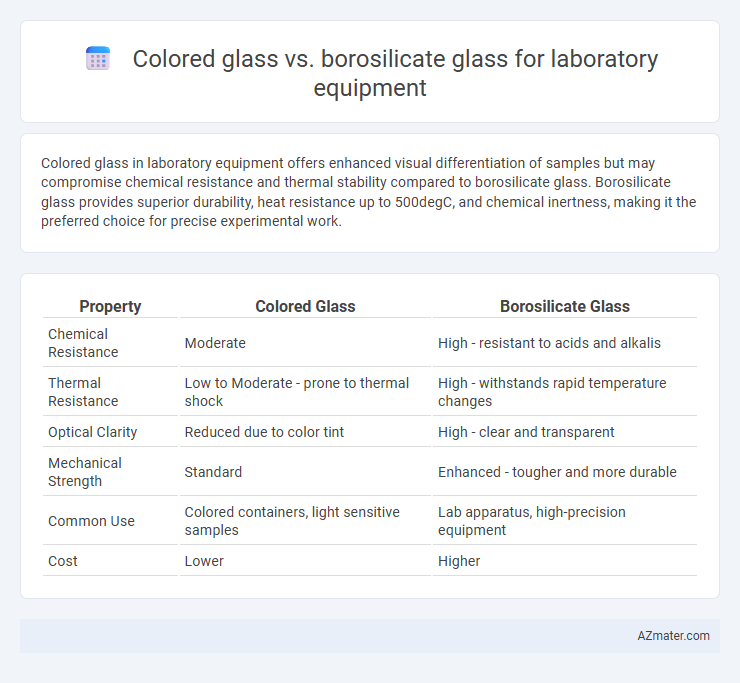Colored glass in laboratory equipment offers enhanced visual differentiation of samples but may compromise chemical resistance and thermal stability compared to borosilicate glass. Borosilicate glass provides superior durability, heat resistance up to 500degC, and chemical inertness, making it the preferred choice for precise experimental work.
Table of Comparison
| Property | Colored Glass | Borosilicate Glass |
|---|---|---|
| Chemical Resistance | Moderate | High - resistant to acids and alkalis |
| Thermal Resistance | Low to Moderate - prone to thermal shock | High - withstands rapid temperature changes |
| Optical Clarity | Reduced due to color tint | High - clear and transparent |
| Mechanical Strength | Standard | Enhanced - tougher and more durable |
| Common Use | Colored containers, light sensitive samples | Lab apparatus, high-precision equipment |
| Cost | Lower | Higher |
Introduction to Laboratory Glassware Materials
Colored glass laboratory equipment offers enhanced protection against specific wavelengths of light, making it ideal for experiments requiring photostability, while borosilicate glass provides superior thermal resistance and chemical durability due to its low coefficient of thermal expansion. Borosilicate glass is commonly preferred in scientific applications for its resistance to thermal shock and chemical corrosion, ensuring reliability in heating and cooling cycles. Colored glass serves specialized functions in reducing light transmission, contributing to sample integrity in photochemically sensitive processes.
Understanding Colored Glass in Laboratories
Colored glass in laboratories serves primarily to filter specific wavelengths of light, protecting sensitive samples and reactions from photo-degradation that can affect experimental outcomes. Compared to borosilicate glass, known for its exceptional thermal and chemical resistance, colored glass offers targeted light absorption but may have lower durability under extreme temperatures or chemical exposure. Selecting colored glass is crucial for experiments requiring light-sensitive materials, ensuring data integrity through effective light filtration while balancing the need for physical and chemical stability in lab environments.
Overview of Borosilicate Glass Properties
Borosilicate glass exhibits exceptional thermal resistance, withstanding temperatures up to 500degC, making it ideal for laboratory equipment exposed to rapid temperature changes. Its low thermal expansion coefficient (approximately 3.3 x 10^-6 /degC) reduces the risk of cracking under thermal stress. Chemical durability against acids, bases, and solvents ensures borosilicate glass maintains integrity and clarity during rigorous laboratory use compared to colored glass variants.
Chemical Resistance: Colored vs Borosilicate Glass
Borosilicate glass exhibits superior chemical resistance compared to colored glass, maintaining stability against strong acids, bases, and solvents commonly used in laboratories. Colored glass often contains additives that may reduce its resistance to certain chemicals, making it less suitable for highly reactive substances. For rigorous chemical applications, borosilicate glass is preferred due to its enhanced durability and resistance to corrosion.
Thermal Stability and Temperature Tolerance
Colored glass has limited thermal stability and generally tolerates temperatures up to 150degC, making it suitable for basic laboratory applications. Borosilicate glass offers superior thermal stability, withstanding rapid temperature changes and temperatures up to 500degC without cracking or deforming. The enhanced temperature tolerance of borosilicate glass makes it the preferred choice for laboratory equipment requiring high heat resistance and durability.
Visibility and Light Transmission Differences
Colored glass laboratory equipment reduces light transmission by absorbing specific wavelengths, which can protect light-sensitive samples but limits visibility of reactions inside the container. Borosilicate glass offers excellent transparency with high light transmission, enabling clear observation and accurate monitoring of experimental processes. The choice depends on balancing protection from light exposure with the need for visual clarity in laboratory applications.
Durability and Mechanical Strength Comparison
Borosilicate glass exhibits superior durability and mechanical strength compared to colored glass, with a high resistance to thermal shock and chemical corrosion, making it ideal for rigorous laboratory conditions. Colored glass, often made from soda-lime glass, tends to have lower mechanical strength and is more prone to breakage under stress or rapid temperature changes. The enhanced structural integrity of borosilicate glass ensures prolonged usability and safety in laboratory equipment subjected to demanding experimental procedures.
Cost Effectiveness and Availability
Colored glass laboratory equipment typically offers lower initial costs and wider availability due to simpler manufacturing processes and common raw materials. Borosilicate glass, recognized for its superior thermal resistance and chemical durability, tends to have higher production expenses, impacting overall affordability. Laboratories must balance budget constraints with performance needs, noting that borosilicate glass's longevity may reduce long-term replacement costs despite its higher upfront price.
Application Suitability in Scientific Experiments
Colored glass offers enhanced light filtering capabilities, making it ideal for experiments requiring protection from specific wavelengths, such as photochemical reactions. Borosilicate glass provides superior thermal resistance and chemical durability, ensuring reliability in high-temperature processes and exposure to corrosive reagents. Selection depends on experimental needs: colored glass optimizes light-sensitive applications, whereas borosilicate glass excels in thermal and chemical stability for diverse laboratory conditions.
Choosing the Right Glassware for Your Laboratory
Colored glass laboratory equipment provides visual distinction and protection against specific light wavelengths, ideal for light-sensitive experiments, while borosilicate glass offers superior thermal resistance, chemical durability, and mechanical strength for general laboratory use. Selecting the right glassware depends on the experimental requirements, such as exposure to heat or light sensitivity, ensuring optimal performance and longevity. Prioritize borosilicate glass for high-temperature or chemical-intensive tasks and choose colored glass when light filtration or sample identification is critical.

Infographic: Colored glass vs Borosilicate glass for Laboratory equipment
 azmater.com
azmater.com